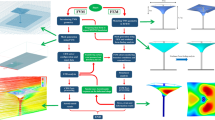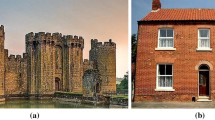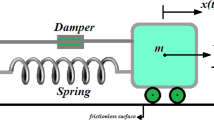Abstract
A modified rigid-object formulation is developed, and employed as part of the fluid–object interaction modeling framework from Akkerman et al. (J Appl Mech 79(1):010905, 2012. https://doi.org/10.1115/1.4005072) to simulate free vibration and flutter of long-span bridges subjected to strong winds. To validate the numerical methodology, companion wind tunnel experiments have been conducted. The results show that the computational framework captures very precisely the aeroelastic behavior in terms of aerodynamic stiffness, damping and flutter characteristics. Considering its relative simplicity and accuracy, we conclude from our study that the proposed free-vibration simulation technique is a valuable tool in engineering design of long-span bridges.
















Similar content being viewed by others
References
Akkerman I, Bazilevs Y, Benson DJ, Farthing MW, Kees CE (2012) Free-surface flow and fluid-object interaction modeling with emphasis on ship hydrodynamics. J Appl Mech 79(1):010905. https://doi.org/10.1115/1.4005072
Takizawa K, Bazilevs Y, Tezduyar TE, Hsu M-C, Øiseth O, Mathisen KM, Kostov N, McIntyre S (2014) Engineering analysis and design with ALE-VMS and space-time methods. Arch Comput Methods Eng 21(4):481–508. https://doi.org/10.1007/s11831-014-9113-0
Tezduyar TE, Behr M, Mittal S, Liou J (1992) A new strategy for finite element computations involving moving boundaries and interfaces. The deforming-spatial-domain/space-time procedure: II. Computation of free-surface flows, two-liquid flows, and flows with drifting cylinders. Comput Methods Appl Mech Eng 94(3):353–371. https://doi.org/10.1016/0045-7825(92)90060-W
Mittal S, Tezduyar TE (1992) A finite element study of incompressible flows past oscillating cylinders and aerofoils. Int J Numer Methods Fluids 15(9):1073–1118. https://doi.org/10.1002/fld.1650150911
Tezduyar TE (2001) Finite element methods for flow problems with moving boundaries and interfaces. Arch Comput Methods Eng 8:83–130. https://doi.org/10.1007/BF02897870
Ed Akin J, Tezduyar TE, Ungor M (2007) Computation of flow problems with the mixed interface-tracking/interface-capturing technique (MITICT). Comput Fluids 36(1):2–11. https://doi.org/10.1016/j.compfluid.2005.07.008
Akkerman I, Bazilevs Y, Kees CE, Farthing MW (2011) Isogeometric analysis of free-surface flow. J Comput Phys 230(11):4137–4152. https://doi.org/10.1016/j.jcp.2010.11.044
Akkerman I, Dunaway J, Kvandal J, Spinks J, Bazilevs Y (2012) Toward free-surface modeling of planing vessels: simulation of the Fridsma hull using ALE-VMS. Comput Mech 50(6):719–727. https://doi.org/10.1007/s00466-012-0770-2
Kees CE, Akkerman I, Farthing MW, Bazilevs Y (2011) A conservative level set method suitable for variable-order approximations and unstructured meshes. J Comput Phys 230(12):4536–4558. https://doi.org/10.1016/j.jcp.2011.02.030
R. P. Selvam, S. Govindaswamy, H. Bosch, Aeroelastic analysis of bridges using FEM and moving grids, Wind and Structures 5 (2\_3\_4) (2002) 257–266. https://doi.org/10.12989/was.2002.5.2_3_4.257. http://koreascience.or.kr/journal/view.jsp?kj=KJKHCF&py=2002&vnc=v5n2_3_4&sp=257
Frandsen JB (2004) Numerical bridge deck studies using finite elements. Part I: Flutter. J Fluids Struct 19(2):171–191. https://doi.org/10.1016/j.jfluidstructs.2003.12.005
Bazilevs Y, Hsu M-C, Takizawa K, Tezduyar TE (2012) ALE-VMS and ST-VMS methods for computer modeling of wind-turbine rotor aerodynamics and fluid-structure interaction. Math Models Methods Appl Sci 22(supp02):1230002. https://doi.org/10.1142/S0218202512300025
Bazilevs Y, Takizawa K, Tezduyar TE (2013) Challenges and directions in computational fluid-structure interaction. Math Models Methods Appl Sci 23(02):215–221. https://doi.org/10.1142/S0218202513400010
Bazilevs Y, Takizawa K, Tezduyar TE, Hsu M-C, Kostov N, McIntyre S (2014) Aerodynamic and FSI analysis of wind turbines with the ALE-VMS and ST-VMS methods. Arch Comput Methods Eng 21(4):359–398. https://doi.org/10.1007/s11831-014-9119-7
Bazilevs Y, Takizawa K, Tezduyar TE (2015) New directions and challenging computations in fluid dynamics modeling with stabilized and multiscale methods. Math Models Methods Appl Sci 25(12):2217–2226. https://doi.org/10.1142/S0218202515020029
Bazilevs Y, Korobenko A, Yan J, Pal A, Gohari SMI, Sarkar S (2015) ALEVMS formulation for stratified turbulent incompressible flows with applications. Math Models Methods Appl Sci 25(12):2349–2375. https://doi.org/10.1142/S021820251540011
Bazilevs Y, Michler C, Calo VM, Hughes TJR (2007) Weak Dirichlet boundary conditions for wall-bounded turbulent flows. Comput Methods Appl Mech Eng 196(49–52):4853–4862. https://doi.org/10.1016/j.cma.2007.06.026
Bazilevs Y, Hughes TJR (2007) Weak imposition of Dirichlet boundary conditions in fluid mechanics. Comput Fluids 36(1):12–26. https://doi.org/10.1016/j.compfluid.2005.07.012
Bazilevs Y, Akkerman I (2010) Large eddy simulation of turbulent Taylor–Couette flow using isogeometric analysis and the residual-based variational multiscale method. J Comput Phys 229(9):3402–3414. https://doi.org/10.1016/j.jcp.2010.01.008
Bazilevs Y, Tezduyar TE (2013) Computational fluid structure interaction methods and application. Wiley, Hoboken. https://doi.org/10.1002/9781118483565
Hsu M-C, Akkerman I, Bazilevs Y (2012) Wind turbine aerodynamics using ALEVMS: validation and the role of weakly enforced boundary conditions. Comput Mech 50(4):499–511. https://doi.org/10.1007/s00466-012-0686-x
Hsu M-C, Kamensky D, Bazilevs Y, Sacks MS, Hughes TJR (2014) Fluid structure interaction analysis of bioprosthetic heart valves: significance of arterial wall deformation. Comput Mech 54(4):1055–1071. https://doi.org/10.1007/s00466-014-1059-4
Yan J, Korobenko A, Deng X, Bazilevs Y (2016) Computational free-surface fluid structure interaction with application to floating offshore wind turbines. Computers & Fluids 141:155–174. https://doi.org/10.1016/j.compfluid.2016.03.008. http://linkinghub.elsevier.com/retrieve/pii/S0045793016300536
Scotta R, Lazzari M, Stecca E, Cotela J, Rossi R (2016) Numerical wind tunnel for aerodynamic and aeroelastic characterization of bridge deck sections. Comput Struct 167:96–114. https://doi.org/10.1016/j.compstruc.2016.01.012
Helgedagsrud TA, Mathisen KM, Bazilevs Y, Øiseth O, Korobenko A (2017) Using ALE-VMS to compute wind forces on moving bridge decks. In: Skallerud B, Andersson HI (eds.) Proceedings of MekIT’17 ninth national conference on computational mechanics, CMIME, Barcelona, Spain, pp. 169–189
Helgedagsrud TA, Bazilevs Y, Korobenko A, Mathisen KM, Øiseth OA (2018) Using ALE-VMS to compute aerodynamic derivatives of bridge sections, Computers Fluids, published online. https://doi.org/10.1016/j.compfluid.2018.04.037. http://linkinghub.elsevier.com/retrieve/pii/S0045793018302330
Takizawa K, Tezduyar TE (2011) Multiscale spacetime fluid structure interaction techniques. Comput Mech 48(3):247–267. https://doi.org/10.1007/s00466-011-0571-z
Takizawa K, Tezduyar TE (2012) Space-time fluid-structure interaction methods. Math Models Methods Appl Sci 22(supp02):1230001. https://doi.org/10.1142/S0218202512300013
Takizawa K, Tezduyar TE, Buscher A, Asada S (2014) Spacetime interface-tracking with topology change (ST-TC). Comput Mech 54(4):955–971. https://doi.org/10.1007/s00466-013-0935-7
Takizawa K, Tezduyar TE, Buscher A (2015) Spacetime computational analysis of MAV flapping-wing aerodynamics with wing clapping. Comput Mech 55(6):1131–1141. https://doi.org/10.1007/s00466-014-1095-0
Takizawa K, Tezduyar TE, Buscher A, Asada S (2014) Spacetime fluid mechanics computation of heart valve models. Comput Mech 54(4):973–986. https://doi.org/10.1007/s00466-014-1046-9
Takizawa K, Tezduyar TE, Terahara T, Sasaki T (2017) Heart valve flow computation with the integrated SpaceTime VMS. Slip interface, topology change and isogeometric discretization methods. Comput Fluids 158:176–188. https://doi.org/10.1016/j.compfluid.2016.11.012. http://linkinghub.elsevier.com/retrieve/pii/S0045793016303681
Takizawa K, Tezduyar TE, Kuraishi T, Tabata S, Takagi H (2016) Computational thermo-fluid analysis of a disk brake. Comput Mech 57(6):965–977. https://doi.org/10.1007/s00466-016-1272-4
Takizawa K, Tezduyar TE, Hattori H (2017) Computational analysis of flow-driven string dynamics in turbomachinery. Comput Fluids 142:109–117. https://doi.org/10.1016/j.compfluid.2016.02.019
Takizawa K, Tezduyar TE, Otoguro Y, Terahara T, Kuraishi T, Hattori H (2017) Turbocharger flow computations with the spacetime isogeometric analysis (ST-IGA). Comput Fluids 142:15–20. https://doi.org/10.1016/j.compfluid.2016.02.021
Otoguro Y, Takizawa K, Tezduyar TE (2017) Spacetime VMS computational flow analysis with isogeometric discretization and a general-purpose NURBS mesh generation method. Comput Fluids 158:189–200. https://doi.org/10.1016/j.compfluid.2017.04.017
Takizawa K, Tezduyar TE, Asada S, Kuraishi T (2016) SpaceTime method for flow computations with slip interfaces and topology changes (ST-SI-TC). Comput Fluids 141:124–134. https://doi.org/10.1016/j.compfluid.2016.05.006
Šarkić A, Fisch R, Höffer R, Bletzinger KU (2012) Bridge flutter derivatives based on computed, validated pressure fields. J Wind Eng Ind Aerodyn 104–106:141–151. https://doi.org/10.1016/j.jweia.2012.02.033
Brusiani F, Miranda SD, Patruno L, Ubertini F, Vaona P (2013) On the evaluation of bridge deck flutter derivatives using RANS turbulence models. J Wind Eng 119:39–47
Bai Y, Yang K, Sun D, Zhang Y, Kennedy D, Williams F, Gao X (2013) Numerical aerodynamic analysis of bluff bodies at a high Reynolds number with three-dimensional CFD modeling. Sci China Phys Mech Astron 56(2):277–289. https://doi.org/10.1007/s11433-012-4982-4
de Miranda S, Patruno L, Ubertini F, Vairo G (2014) On the identification of flutter derivatives of bridge decks via RANS turbulence models: Benchmarking on rectangular prisms. Eng Struct 76:359–370. https://doi.org/10.1016/j.engstruct.2014.07.027
Nieto F, Owen JS, Hargreaves DM, Hernández S (2015) Bridge deck flutter derivatives: efficient numerical evaluation exploiting their interdependence. J Wind Eng Ind Aerodyn J 136:138–150
Patruno L (2015) Accuracy of numerically evaluated flutter derivatives of bridge deck sections using RANS: effects on the flutter onset velocity. Eng Struct 89:49–65. https://doi.org/10.1016/j.engstruct.2015.01.034
Diana G, Rocchi D, Belloli M (2015) Wind tunnel : a fundamental tool for long-span bridge design. Struct Infrastruct Eng Maint Manag Life Cycle Des Perform 11(4):533–555. https://doi.org/10.1080/15732479.2014.951860
Siedziako B, Øiseth O, Rønnquist A (2017) An enhanced forced vibration rig for wind tunnel testing of bridge deck section models in arbitrary motion. J Wind Eng Ind Aerodyn 164:152–163. https://doi.org/10.1016/j.jweia.2017.02.011
Scanlan RH, Tomko J (1971) Airfoil and bridge deck flutter derivatives. J Eng Mech Div 97(6):1717–1737
Svend Ole Hansen APS, The Hardanger bridge: static and dynamic wind tunnel tests with a section model. Technical report, prepared for Norwegian Public Roads Administration, Tech. rep. (2006)
Hughes TJR, Liu WK, Zimmermann TK (1981) Lagrangian-Eulerian finite element formulation for incompressible viscous flows. Comput Methods Appl Mech Eng 29(3):329–349. https://doi.org/10.1016/0045-7825(81)90049-9
Hughes T, Tezduyar T (1984) Finite element methods for first-order hyperbolic systems with particular emphasis on the compressible euler equations. Comput Methods Appl Mech Eng 45(1–3):217–284. https://doi.org/10.1016/0045-7825(84)90157-9
Hughes TJ, Franca LP, Balestra M (1986) A new finite element formulation for computational fluid dynamics. : V. Circumventing the babuška-brezzi condition: a stable Petrov-Galerkin formulation of the stokes problem accommodating equal-order interpolations. Comput Methods Appl Mech Eng 59(1):85–99. https://doi.org/10.1016/0045-7825(86)90025-3
Tezduyar T, Park Y (1986) Discontinuity-capturing finite element formulations for nonlinear convection-diffusion-reaction equations. Comput Methods Appl Mech Eng 59(3):307–325. https://doi.org/10.1016/0045-7825(86)90003-4
Tezduyar TE, Osawa Y (2000) Finite element stabilization parameters computed from element matrices and vectors. Comput Methods Appl Mech Eng 190:411–430. https://doi.org/10.1016/S0045-7825(00)00211-5
Tezduyar TE (2003) Computation of moving boundaries and interfaces and stabilization parameters. Int J Numer Methods Fluids 43(5):555–575. https://doi.org/10.1002/fld.505
Hughes TJR, Sangalli G (2007) Variational multiscale analysis: the fine scale Green’s function, projection, optimization, localization, and stabilized methods. SIAM J Numer Anal 45(2):539–557. https://doi.org/10.1137/050645646
Hsu M-C, Bazilevs Y, Calo V, Tezduyar T, Hughes T (2010) Improving stability of stabilized and multiscale formulations in flow simulations at small time step. Comput Methods Appl Mech Eng 199(13–16):828–840. https://doi.org/10.1016/j.cma.2009.06.019
Takizawa K, Tezduyar TE, Kuraishi T (2015) Multiscale spacetime methods for thermo-fluid analysis of a ground vehicle and its tires. Math Models Methods Appl Sci 25(12):2227–2255. https://doi.org/10.1142/S0218202515400072
Takizawa K, Tezduyar TE, Mochizuki H, Hattori H, Mei S, Pan L, Montel K (2015) Spacetime VMS method for flow computations with slip interfaces (ST-SI). Math Models Methods Appl Sci 25(12):2377–2406. https://doi.org/10.1142/S0218202515400126
K. Takizawa, T. E. Tezduyar, Y. Otoguro, Stabilization and discontinuity-capturing parameters for spacetime flow computations with finite element and isogeometric discretizations, Comput Mech.published online (2018). https://doi.org/10.1007/s00466-018-1557-x
Bazilevs Y, Calo VM, Hughes TJR, Zhang Y (2008) Isogeometric fluid-structure interaction: theory, algorithms, and computations. Comput Mech 43(1):3–37. https://doi.org/10.1007/s00466-008-0315-x
Stein K, Tezduyar T, Benney R (2003) Mesh moving techniques for fluid-structure interactions with large displacements. J Appl Mech 70(1):58. https://doi.org/10.1115/1.1530635
Tezduyar TE, Behr M, Mittal S, Johnson AA (1992) Computation of unsteady incompressiblke flows and massively parallel implementations. New Methods Transient Anal 246:7–24
Tezduyar T, Aliabadi S, Behr M, Johnson A, Mittal S (1993) Parallel finite-element computation of 3D flows. Computer 26(10):27–36. https://doi.org/10.1109/2.237441
Johnson A, Tezduyar T (1994) Mesh update strategies in parallel finite element computations of flow problems with moving boundaries and interfaces. Comput Methods Appl Mech Eng 119(1–2):73–94. https://doi.org/10.1016/0045-7825(94)00077-8
Hughes TJR, Winget J (1980) Finite rotation effects in numerical integration of rate constitutive equations arising in large-deformation analysis. Int J Numer Methods Eng 15(12):1862–1867. https://doi.org/10.1002/nme.1620151210
Jansen KE, Whiting CH, Hulbert GM (2000) A generalized-\(\alpha \) method for integrating the filtered Navier-Stokes equations with a stabilized finite element method. Comput Methods Appl Mech Eng 190:305–319
Kuhl E, Hulshoff S, de Borst R (2003) An arbitrary lagrangian eulerian finite-element approach for fluid-structure interaction phenomena. Int J Numer Methods Eng 57(1):117–142. https://doi.org/10.1002/nme.749
Dettmer WG, Peric D (2006) A computational framework for fluid-structure interaction: finite element formulation and applications. Comput Methods Appl Mech Eng 195:5754–5779
Øiseth O, Rönnquist A, Sigbjörnsson R (2010) Simplified prediction of wind-induced response and stability limit of slender long-span suspension bridges, based on modified quasi-steady theory: A case study. J Wind Eng Ind Aerodyn 98(12):730–741. https://doi.org/10.1016/j.jweia.2010.06.009
Scanlan RH (1993) Problematics in formulation of wind force models for bridge decks. J Eng Mech 119(7):1353–1375. https://doi.org/10.1061/(ASCE)0733-9399(1993)119:7(1353)
Bartoli G, Contri S, Mannini C, Righi M (2009) Toward an improvement in the identification of bridge deck flutter derivatives. J Eng Mech 135(8):771–785. https://doi.org/10.1061/(ASCE)0733-9399(2009)135:8(771)
Tezduyar TE (2001) Finite element interface-tracking and interface-capturing techniques for flows with moving boundaries and interfaces. In: Proceedings of the ASME symposium on fluid-physics and heat transfer for macro- and micro-scale gas-liquid and phase-change flows (CD-ROM), ASME Paper IMECE2001/HTD-24206, ASME, New York, New York
Stein K, Tezduyar TE, Benney R (2004) Automatic mesh update with the solid-extension mesh moving technique. Comput Methods Appl Mech Eng 193(21–22):2019–2032. https://doi.org/10.1016/j.cma.2003.12.046
Hsu MC, Akkerman I, Bazilevs Y (2011) High-performance computing of wind turbine aerodynamics using isogeometric analysis. Comput Fluids 49(1):93–100. https://doi.org/10.1016/j.compfluid.2011.05.002
Acknowledgements
This work was carried out with financial support from the Norwegian Public Roads Administration. All simulations were performed on resources provided by UNINETT Sigma2 - the National Infrastructure for High Performance Computing and Data Storage in Norway. YB was partially supported through AFOSR Award No. FA9550-16-1-0131. The authors greatly acknowledge this support.
Author information
Authors and Affiliations
Corresponding author
Additional information
Publisher's Note
Springer Nature remains neutral with regard to jurisdictional claims in published maps and institutional affiliations.
Rights and permissions
About this article
Cite this article
Helgedagsrud, T.A., Bazilevs, Y., Mathisen, K.M. et al. Computational and experimental investigation of free vibration and flutter of bridge decks. Comput Mech 63, 121–136 (2019). https://doi.org/10.1007/s00466-018-1587-4
Received:
Accepted:
Published:
Issue Date:
DOI: https://doi.org/10.1007/s00466-018-1587-4




